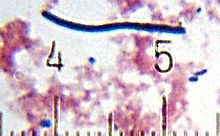How it Works
There are lots of different "yogurts" but they all have some similar beginnings. The characteristic taste, texture and smell of yogurt comes from two bacteria; Lactobacillus bulgaricus (a rod shaped bacteria) and Streptococcus thermophilus (a round or coccus shaped bacteria).
 |
| Lactobacillus bulgaricus |
 |
| Streptococcus thermophilus |
These guys work well together
- Rod/cocci blends grow together in a relationship referred to as 'mutualism' where the overall growth rate and acid production is faster than either culture on its own. The rods produce amino acids and peptides which stimulate the growth of cocci, and the cocci produce formic acid which is required by rods.
- The balance between the rods and cocci can be controlled by temperature and pH
- The cocci prefer higher temperatures (optimum about 46C) than the rods (optimum about 39C).
- The rods are more acid tolerant than the cocci, so, normally the cocci develop the initial acidity and out grow the rods. But, as the acidity increases the rods begin to grow faster than the cocci.
As an added bonus the L. bulgaricus produces acetaldehyde  this is the chemical that gives yogurt its familiar taste and smell.
this is the chemical that gives yogurt its familiar taste and smell.
 this is the chemical that gives yogurt its familiar taste and smell.
this is the chemical that gives yogurt its familiar taste and smell.The low pH gives yogurt it's tangy bite and also the low pH starts to denature the Casein proteins and makes the yogurt nice and thick.
A note on ProBiotics" Lactobacillus acidophilus - Acidophilus bacteria are one of the homofermentative species that like the other bacteria in this receipe ferment milk sugar Lactose to lactic acid and grow well at pH <5.0 and temperatures of 37 C. The commercial starter I used contained L. acidophilus. A range of lactic acid bacteria are naturally occuring in human systems and are considered to contribute to a wide range of positive health impacts.